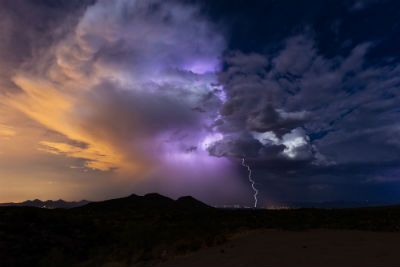
The peak of the U.S. East Coast hurricane season extends from mid-August to late October. Severe weather may affect farms in a variety of ways, but the powerful winds and flooding rains of hurricanes can be disastrous for farmers, their families and livestock. VDACS encourages farmers to act now and take precautions to help protect their families, livestock and farm operations.
The following are a few preparedness steps farmers can take before a storm.
- Monitor local weather reports for up-to-the-minute storm information.
- Create an emergency kit with flashlights, batteries, drinking water and food for humans and pets that will last three to four days, medications, emergency numbers, first aid kit, dust masks.
- Make a communications plan that identifies evacuation routes and a meeting destination for your family in the event you need to evacuate.
- Charge cell phone batteries and gather extra batteries for radios.
- Secure livestock and other animals. If necessary, build berms for them to stand on in low-lying areas that are prone to flooding.
- Stock up on feed, water and livestock supplies so that you are self-sustainable for at least three days.
- Mark animals with an identifier so they can be returned if lost. This can include ear tags with the name of the farm and/or phone numbers, paint markings on hooves or coat, or clipped initials in the hair.
- Store and secure items or equipment that may blow away or become dangerous projectiles.
- Inspect all barns, outbuildings and other structures for broken or weak components and make repairs before the storm arrives.
- Stock up on nails, screws and plywood to board up windows and nail doors and windows shut.
- If your operation uses vent fans, water pumps, milking machines or other critical electrical equipment, purchase a gas-powered generator and plenty of fuel.
- Store fertilizers, pesticides, treated seeds and other such products away from floodwaters and animals.
- Do not drive across any flooded roadway, as it only takes six inches of water to move a vehicle and roads may be washed out beneath the floodwaters.
- If strong winds knock down trees, make farm lanes and houses accessible to delivery vehicles as soon as it is safe to do so.
- Coordinate with neighbors before the storm to discuss what resources can be shared in the event of power outages or flooding.
- Have contact information for your local emergency manager, sheriff, and animal control office readily available.
- For more emergency preparation tips, visit www.vaemergency.gov/hurricanes.
“I encourage all agricultural producers to prepare their farms and agribusinesses now for hurricanes and other severe weather events. Proper planning and taking precautions before a storm arrives could save thousands of dollars in property loss,” said Brad Copenhaver, commissioner of VDACS.
VDACS offers the following tips for horse owners in areas prone to hurricane damage:
- Keep multiple forms of identification for your horse.
- Store the record for the microchip number, if present, in an accessible location. VDACS also recommends keeping a second copy of this information with a family member or friend in a distant location but where it will be easily accessible.
- Be sure your horse’s vaccinations for tetanus and the encephalitis viruses (Eastern Equine Encephalitis and West Nile Virus) are current.
- Coastal residents should consider evacuating horses to a sufficient distance from the coast and out of a storm’s path. In addition, horse owners should make plans of how they would acquire any special equipment that may be needed to transport horses prior to an emergency event.
VDACS also encourages pesticide applicators, particularly those in Eastern Virginia, to secure their pesticide storage areas. Applicators in low-lying areas should attempt to elevate or move pesticides to locations that are less likely to flood. Pest control companies should consider the weather carefully when making any type of outdoor application and always read and follow the pesticide label.










